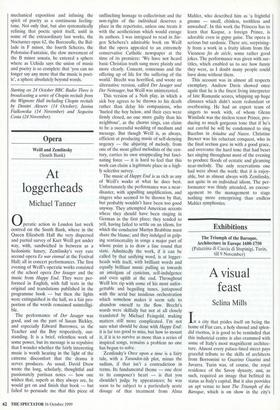Exhibitions
The Triumph of the Baroque, Architecture in Europe 1600-1750 (Palazzina di Caccia di Stupinigi, Turin, till 9 November)
A visual feast
Selina Mills
In a city that prides itself on being the home of Fiat cars, a holy shroud and splen- did risottos, it is good to be reminded that this industrial centre is also crammed with some of Italy's most magnificent architec- ture. Almost every palace-lined street pays graceful tribute to the skills of architects from Borromini to Guarino Guarini and Juvarra. Turin was, of course, the royal residence of the Savoy dynasty, and, as such, required an image that befitted its status as Italy's capital. But it also provides an apt venue to host The Triumph of the Baroque, which is on show in the city's
recently renovated Palazzo Stupinigi.
Staged over 22 rooms and grouped into different types of buildings (royal, military, ecclesiastical, private etc.), the exhibition explores the new style of architecture that emerged in Europe between 1600 and 1750. Bringing together for the first time over '80 original architects' models, 400 paintings, sketches and foundation medals, the result, like Turin, is a spectacular, com- plex and distinguished visual feast. It is an event, however, that might make you buy good walking shoes (the exhibition space is over 1 kilometre long) and a Fiat from the local factory to carry home the hefty 3-kilo catalogue.
What is instantly striking about the exhi- bition is how the term 'Baroque' is applied to a variety of architectural styles, from the Classical and Mannerist to the Gothic and Palladian. Beginning in Rome, the first rooms demonstrate how early visionaries used complex and playful interpretations of Classical forms to guide new works, such as Carlo Mademo's Basilica of St Peter (1609- 1615) and Bernini's bozzetti (wooden mod- els) for the river gods in his Four Rivers Fountain in the Piazza Navona. Further rooms, however, show how different nations and regions expressed their identi- ties through what they chose to keep or reject from the Roman synthesis. Dutch style tended towards Palladian forms (even in its windmills); northern Italy towards open space and arcades (hence Turin); while Swedish design used the fortified cas- tle look, even in town. Baroque, therefore, is used as a cultural term, which was 'tri- umphant' because of its ability to incorpo- rate different styles, and to be the leading architectural form for more than a century and a half.
There are, however, difficulties with the presentation of this premise, whether one agrees with it or not. There is very little detail provided about the models on dis- play, save their names and dates and badly illuminated quotes on the wall. There is also little analysis of why the 'new style' of architecture was so new, in light of the Renaissance, and little guidance as to how previous art historians have interpreted this period, except in the heavy, expensive, but brilliant catalogue. Moreover, while wads of architectural vocabulary would make this exhibition even longer than it is (it takes around three to four visits to appreci- ate it fully), the commentary that does exist assumes a knowledge that many might not have. This is a show to look at rather than one that informs.
The exhibition, however, is not limited by this and, if you are willing to carry the cata- logue or listen to the audio-guide, the exceptional range of models and paintings shows how popes and sovereigns, from Russia to Sicily, used architecture as a visu- al tool to confirm and strengthen power bases. Room 4, for example, houses the splendid full-scale model of the royal palace at the Kremlin, built by Vasily Ivanovich Bazhenov in 1769 for Catherine II. The immense size (it is over 10 metres long) and precision of detail pays great tribute to the architect's vision and crafts- manship. But it also records (as does William Kent's model for a royal palace in Richmond for George II) that often drafts and models did not materialise into build- ings, and it was almost more important to have commissioned a palace in theory than it was to have one in practice. Building a model, claimed Bazhenov, was half the work in the first place.
The Triumph of the Baroque is a coura- geously conceived exhibition that offers an extensive collection of architectural visions. It is fascinating to see the aging scraps of draft paper that ultimately resulted in edi- fices which now form part of our cultural heritage, such as St Peter's or the Louvre. It is also interesting to compare the variety of international styles, and to consider how many architects worked on one project, such as the Greenwich Hospital (1694) which lists Nicholas Hawksmoor, Sir John Vanbrugh and Sir Christopher Wren among its many creators.
If you fail to reach Turin, the exhibition goes on tour to Montreal, Washington and Marseilles next year in a thankfully edited version.
Model of the Kremlin by Vasili Ivanovich Bazhenov



















































































 Previous page
Previous page